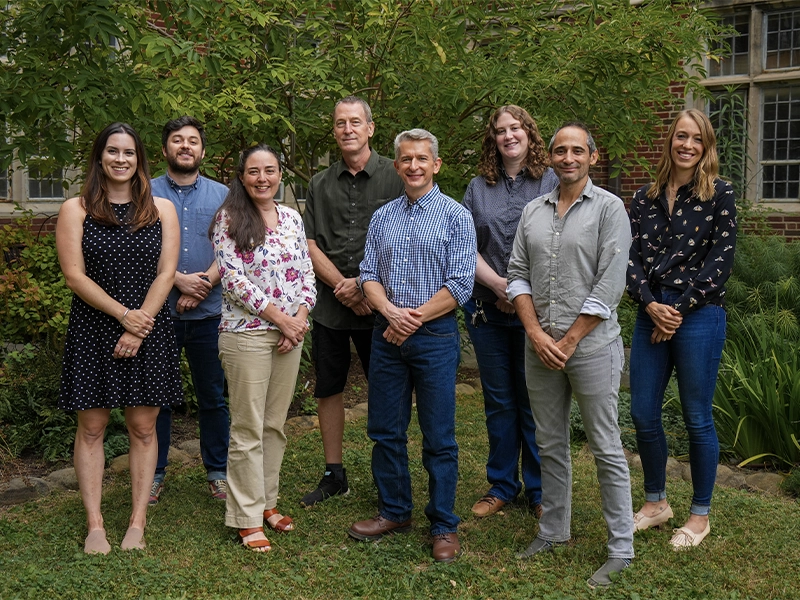
Collaborative for Animal Behavior (CoLAB)
We strive to enable cutting-edge collaborative research on animal behavior in dynamic environments and to provide excellent education, research mentorship, and opportunities for postdoctoral scholars, graduate students, and undergraduate students.
Overview
We live in a time of unprecedented environmental change. Increases in noise and light pollution are reorganizing communities by interfering with the perception of environmental time-cues, habitat features, and auditory and visual signals. Escalating temperatures are causing harmful effects on cognition, health, and survival. Emerging pathogens change the ways we, among other animals, behave. Understanding how animals perceive and behaviorally respond to environmental change is critical as the Anthropocene reshapes the ecological and evolutionary landscapes animals, including humans, occupy. Our Center addresses this foundational challenge of understanding how animals collectively construct their perception and behaviorally respond to a changing world by making fundamental advances within three complementary theme areas:
- Theme 1: Behavioral Responses to a Changing Environment.
- Theme 2: Information Transfer in Human-Altered Environments.
- Theme 3: Quantitative Methods to Understand the Generative Principles from which Behavior Emerges.
People

Elizabeth Derryberry
Professor, Ecology & Evolutionary Biology
Director, Collaborative for Animal Behavior
Outreach Director National Institute for Modeling Biological Systems
The Derryberry lab works on animal communication, particularly bird song. We ask questions such as how does the environment affect sensory and signaling systems? What are the functional consequences of signal evolution in the context of competition and mate choice? Other work in the lab aims to understand avian diversification using robust phylogenies and how behavior buffers organisms from heat in the face of climate change

Blair Downey
Assistant Professor, Animal Science
The Downey lab investigates how domestic animals perceive and respond to common management practices to improve animal welfare. We are primarily interested in understanding how barren environments, especially in early life, affect behavior and cognition in dairy cattle.

Todd M. Freeberg
Professor and Associate Head, Department of Psychology
Director of the College Scholars Honors Program in the College of Arts & Sciences
The Freeberg lab studies how variation in social groups influences the ways individuals communicate and make behavioral decisions. A major line of research involves testing the role of social complexity in driving variation in vocal signaling in chickadee and titmouse species. We use naturalistic observational and experimental approaches in both field and semi-natural aviary settings. We have recently begun testing the role of social contextual variables on decisions about shelter choice in cockroaches.

Daniel Hembree
Professor, Earth, Environmental & Planetary Sciences
The Hembree lab investigates the record of terrestrial animal behavior through Earth history through the study of fossil burrows, borings, tracks, and trails. Interpreting the significance of these fossils involves the study of modern analog animals in the laboratory and field. We work primarily with soil invertebrates with the goal of understanding the long-term effects of environmental and climatic change on animal behavior.

Claire Hemingway
Assistant Professor, Ecology & Evolutionary Biology
Assistant Professor, Psychology
Research Associate, Smithsonian Tropical Research Institute
The Hemingway lab broadly explores the mechanisms, outcomes, and evolutionary consequences of animal decision-making. To address this question, we study foraging behavior in both bats and bees. Specifically, we ask how animals evaluate and make decisions between foraging options based on each option’s signal and reward properties. We also ask whether species differ in decision-making mechanisms based on their foraging strategy or other aspects of their ecology. Finally, we are interested in how certain decision mechanisms may shape the targets of those decisions, such as floral signals and rewards.

Kimberly S. Sheldon
Associate Professor Ecology & Evolutionary Biology
The Sheldon Lab examines the patterns and processes leading to the distribution of organisms and uses this information to predict impacts of anthropogenic change on species and ecological communities. We work across broad latitudinal and elevational gradients and integrate the fields of physiology, behavior, ecology, and evolution. We work with a variety of taxa, but much of our experimental research is with dung beetles.

Sebastian Stockmaier
Assistant Professor Ecology & Evolutionary Biology
Research Associate, Smithsonian Tropical Research Institute
The Stockmaier lab works at the intersection of behavioral and disease ecology. We are interested in the reciprocal interactions between pathogens and behavior, particularly in social contexts. We aim to explore the ecological, evolutionary, and epidemiological implications arising from these interactions. We study this predominantly in neotropical bats but are constantly looking to expand our repertoire of animal systems to answer our questions.

Jessie C. Tanner
Assistant Professor, Ecology & Evolutionary Biology
Assistant Professor, Psychology
Affiliated Faculty, Appalachian Justice Research Center
The Tanner lab addresses fundamental questions about the evolution of animal communication. We work primarily with acoustically communicating animals, including treefrogs and field crickets, to understand receiver decision-making and its evolutionary consequences.

Alejandro Vélez
Assistant Professor, Psychology
The Vélez lab integrates ecological, behavioral, physiological, and anatomical studies, under a comparative framework, to investigate the mechanisms, function, and evolution of animal communication signals and signal-processing mechanisms.
Emeritus
Collectively, these researchers have not only advanced the scientific understanding of animal behavior but have also played pivotal roles in establishing and leading research initiatives at the University of Tennessee. The Collaborative for Animal Behavior aims to build upon the strong foundation of groundbreaking research and unwavering dedication established by these esteemed researchers.

Susan Riechert
Dr. Susan Riechert is renowned for her extensive research on spider behavior and ecology. Her work has provided deep insights into behavioral ecology, particularly in understanding how environmental factors influence behavioral strategies in spiders. During her work with Agelenopsis aperta, she played a key role in uncovering an important class of medicines to treat brain health, inspired by agatoxins. Her research not only advanced the understanding of these compounds but also demonstrated their potential therapeutic applications, paving the way for innovative treatments in neuroscience. At the University of Tennessee, she has been instrumental in promoting research and education in animal behavior, mentoring numerous students and contributing to the development of the department’s research capabilities. She also founded Biology in a Box (now Easy as Play), a K12 program that employs a hands-on inquiry-based approach to teaching STEM.

Gordon Burghardt
Dr. Gordon Burghardt is an Alumni Distinguished Professor Emeritus of Psychology and Ecology and Evolutionary Biology. His research and writings have focused on comparative behavioral development in many species, including iguanas, black bears, turtles, crocodylians, and especially chemoreception, feeding, antipredator behavior, and sociality in snakes. He is probably best known for his pioneering work in the study of play behavior across various animal species, including reptiles. His research has expanded the understanding of the evolutionary, developmental, and theoretical aspects of play. He has also worked on conceptual and historical aspects of ethology and comparative psychology, written and edited several books, and served as editor of several journals. At the University of Tennessee, Dr. Burghardt has been a key figure in advancing the study of animal behavior, fostering interdisciplinary collaborations, including the interdisciplinary Life Sciences Program in Ethology (prior to EEB coming into existence) and enhancing the university’s reputation in this field. He recently was awarded (2024) the Distinguished Animal Behaviorist Award by the Animal Behavior Society. He also serves as a core member of NeuroNET, a UT based research center whose mission is to foster and support cutting edge research and training in brain science.

Gary McCracken
Dr. Gary McCracken has made significant contributions to the study of bat behavior, ecology, and conservation. His research has pioneered studies on bat social behavior, communication, population dynamics, and ecosystem services. Dr. McCracken’s work has linked the use of molecular tools to studies of behavior, foraging, and high-altitude flight, and to document the roles of bats in preserving ecosystem health. At the University of Tennessee, he has led research initiatives focused on bat conservation and has been active in promoting evolutionary research and education. He is a recipient of the Miller Award – the highest award for research on bats – and, in 2020, was awarded the Macebearer award, the highest faculty honor at the University of Tennessee.
Programs
Register for the Inaugural Southeastern Conference for Animal Behavior (SeCAB)!
We live in a time of unprecedented environmental change. Noise and light pollution disrupt sensory cues, habitat destruction alters landscapes, and rising temperatures challenge cognition, health, and survival. Behavior is at the forefront of adaptation to these shifts, shaping how animals perceive and respond to their changing world.
To understand when and how behavior meets these challenges, behavioral biologists are drawing from an ever-expanding toolkit—combining machine learning and epigenetics with cognitive assays, field experiments, and neural circuit analysis. These integrative approaches allow us to trace how animals sense their environment, process information, and act in ways that influence survival and reproduction under rapidly shifting conditions.
The Southeastern Conference for Animal Behavior brings together researchers to explore these dynamic interactions and to mobilize and expand the network of behavioral biologists in the Southeast. By fostering collaboration and exchange, this conference aims to strengthen regional research connections and advance our understanding of behavioral adaptation in a changing world.
Agriculture and Natural Resource Building
Room 101/101A, Knoxville, TN 37996
September 26-27, 2025 (itinerary coming soon)
Friday, 4:00 – 7:00pm: plenary speaker, poster session, social
Saturday, 9:00am – 5:00pm: talks, lunch (on your own), and more talks!
Nearby lodging options (no room blocks reserved):
- Marriott Knoxville Downtown
- Hilton Knoxville
- Hampton Inn & Suites
- Crowne Plaza Knoxville
Scholarship & Initiatives
The B.A. in Animal Behavior offers an interdisciplinary foundation, including courses from the natural sciences, social sciences, and humanities to explore animal behavior from multiple perspectives. This degree prepares students for careers in research, wildlife biology, conservation, veterinary medicine, animal training, and more. Through coursework and hands-on experiences, students investigate the causes and evolution of animal behavior, gaining insights into both biological and environmental influences. Opportunities for independent research, internships, and laboratory work prepare students to apply their skills in settings such as zoos, wildlife centers, and museums.
EEB/PSYCH 450
Animal Behavior
Behaviors are some of the most conspicuous, extraordinary, and sometimes puzzling traits of organisms. In this survey of animal behavior, we draw from a variety of interrelated fields, including ecology and evolutionary biology, psychology, neuroscience, endocrinology, biochemistry and physics, to understand the proximate and ultimate causes of animal behavior.
EEB/PSYCH 459
Comparative Animal Behavior Laboratory
In this laboratory course, we take a hands-on approach to the study of animal behavior. Work in this field is aimed at uncovering the mechanisms, development, function, and evolution of behavioral systems in non-human animals. This course is designed to authentically engage students in the process of science. Students build a background in ethics, experimental design, and statistical analysis and then work as part of a team to design and carry out an experiment.
EEB/PSYC 454
Animal Communication
Animal communication is the deeply interdisciplinary field aimed at understanding the mechanisms, development, function, and evolution of communication in animals. Why and how do animals communicate? By what mechanisms do animals produce and perceive signals? What information is communicated with signals? How are animal signals shaped by natural and sexual selection? How do signals propagate in the environment?
EEB 607
Special Topics in Animal Behavior
Special Topics in Animal Behavior is a graduate-level seminar in which students engage with cutting-edge research in our field and interact closely with faculty affiliated with the UTABC. Students and faculty present works in progress and benefit from offering and responding to constructive feedback.
EEPS 420/520
Trace Fossils: Behavior, Environment, and Applications
An investigation of organism-substrate interactions during the present and throughout geologic time. Topics include ichnologic theory, a review of modern and ancient trace makers, ichnofacies models, and applications to sedimentologic and stratigraphic problems, environmental impacts on substrate-dependent ecosystems, as well as oil, gas, and groundwater exploration.
ANSC 490/515
Animal Behavior and Welfare
This course is designed to encourage critical thought about animal welfare in human-managed species. Students analyze contemporary welfare issues and policies based on our scientific understanding of animal experiences. While the course emphasizes farm animals, it also draws on examples from zoo, lab, companion, wild, and rehabilitation settings.
EEB 315
Parasites, Disease, and Behavior
Have you ever wondered how animals, including humans, practice social distancing to prevent the spread of pathogens or how parasites manipulate the behavior of their hosts. This course will introduce students to the many ways human and non-human animals change their behavior in response to parasites. For each behavior, we will explore the underlying evolutionary and ecological contexts and epidemiological implications.
Request information
To subscribe to the listserv, do the following:
- Address an e-mail message to listserv@listserv.utk.edu; the Subject does not matter.
- Put the following in the body of the message:
- subscribe colab yourfirstname yourlastname
- A confirmation message will be sent to your e-mail address asking you to confirm your subscription request. Confirm your subscription request by clicking on the first link in the body of the message.